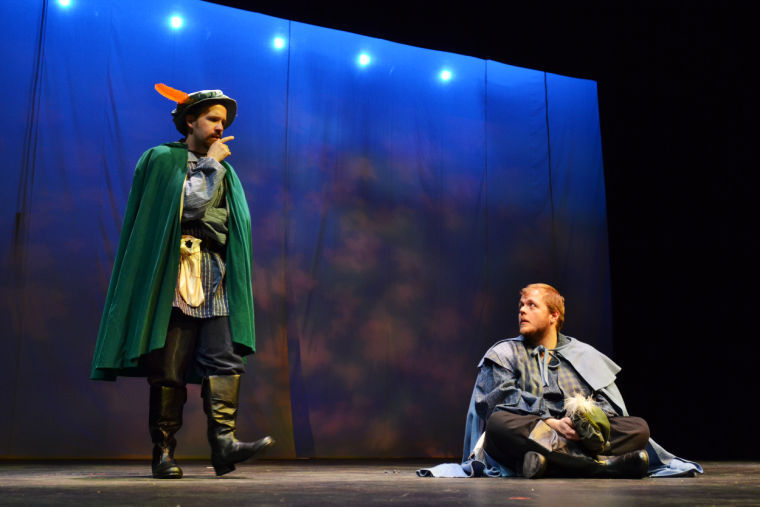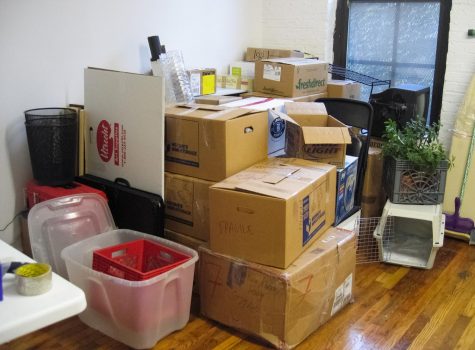What Shakespeare forgot
Members of STAGE rehearse for their upcoming performance of “Rosencrantz & Gildenstern Are Dead” in Daggy Hall, Wednesday, April 2.
April 7, 2014
William Shakespeare’s timeless tale “Hamlet” takes a raunchy turn for the best this weekend with Tom Stoppard’s “Rosencrantz and Guildenstern are Dead” at Jones Theatre in Daggy Hall. The show opened this last weekend, April 4, and I was given the opportunity to watch it twice.
Having read “Rosencrantz and Guildenstern are Dead” in high school, I was ecstatic to see the script come to life on stage. With comedic dialogue, a man dressed in a skirt, and some questionable moments, I walked away befuddled and amused.
“It talks about fate and existentialism and the condition of these two very minor characters that are basically just plot points in ‘Hamlet’,” director Benjamin Gonzales said.
While the dialogue might go over someone’s head at times, Rosencrantz’s child-like speech and Guildenstern’s fast-paced oratory make up for the confusion.
“It’s bizarre,” said Emily Smith, who plays a Tragedian. “I only understand it because I’m in the show.”
Bizarre is an apt adjective for this show, but it’s one of the things that make it comedic. The actors’ movements and dialogue, especially the Tragedians’, are exaggerated and over-the-top.
“I have a lot of stage time but only one line,” said Harley Reynolds, Tragedian and Ophelia in the show.
The Tragedians don’t speak much in comparison to their leader, the Player, and Rosencrantz and Guildenstern. They do more dumb show acting, where they act through movement instead of speaking, which often reflects the Player’s words.
“You’re communicating through facial expressions,” Smith said.
The cast that makes up the Tragedians includes actors playing actors playing other characters in the show, Smith said. The exceptions are the Player, Rosencrantz and Guildenstern.
“Ben did this really cool thing where all the cast except Rosencrantz and Guildenstern are Tragedians,” she said. “We all got to create our own Tragedian. My character is a pathological liar.”
The play starts off more calm and quiet with Rosencrantz and Guildenstern flipping coins and the coin landing heads every time. This leads to a lengthy discussion of probabilities and why they stood where they did at the moment.
Then comes in the Tragedians, a flamboyant and boisterous bunch of actors led by the Player. The Tragedians’ outfits are very simplistic while the Player is dressed more elegantly, complete with a patches cape, dagger, and a skirt made of neckties.
Actors playing the Tragedians also play characters from “Hamlet” such as Ophelia, Claudius, Gertrude, and Prince Hamlet.
“The entire world that’s created actually comes out of the Tragedians,” Gonzales said. “‘Hamlet’ isn’t necessarily ‘Hamlet.’ It sort of ends up becoming a play within a play within a play.”
Audience members don’t need to have read “Hamlet” to understand the show. Multiple scenes in the play are directly from or reference the play, but just in case, there is also a “Hamlet in a Nutshell” description of the play in the program.
Apart from the costumes, the Tragedians’ and Player’s faces are painted in a way that’s clownish but also a little haunting, which makes them look ghoulish.
One scene that caused much laughter was the game of questions between with Rosencrantz and Guildenstern, adapted into an untraditional fencing match. Instead of touching with the point of the rapier, the two characters swat each other with their blades.
Keep an ear out for the background music and sound effects. A soft, whistling wind indicates the Player has come onstage, even when the other characters don’t realize it.
For the sake of clarity, parents are advised that this may not be the best show for children. Much of the dialogue will go right over their heads. There are some suggestive dialogue and actions along with a character “giving the bird” to her fellow actors.
Overall, the show left audiences laughing throughout the production, even if some laughs seemed out of confusion about the chaos. Rosencrantz and Guildenstern cause much confusion on who’s who.
“Rosencrantz and Guildenstern are Dead” will play Friday and Saturday at 7:30 p.m. with a 2 p.m. matinee Saturday. Tickets cost $8 for students and $10 for adults.





















